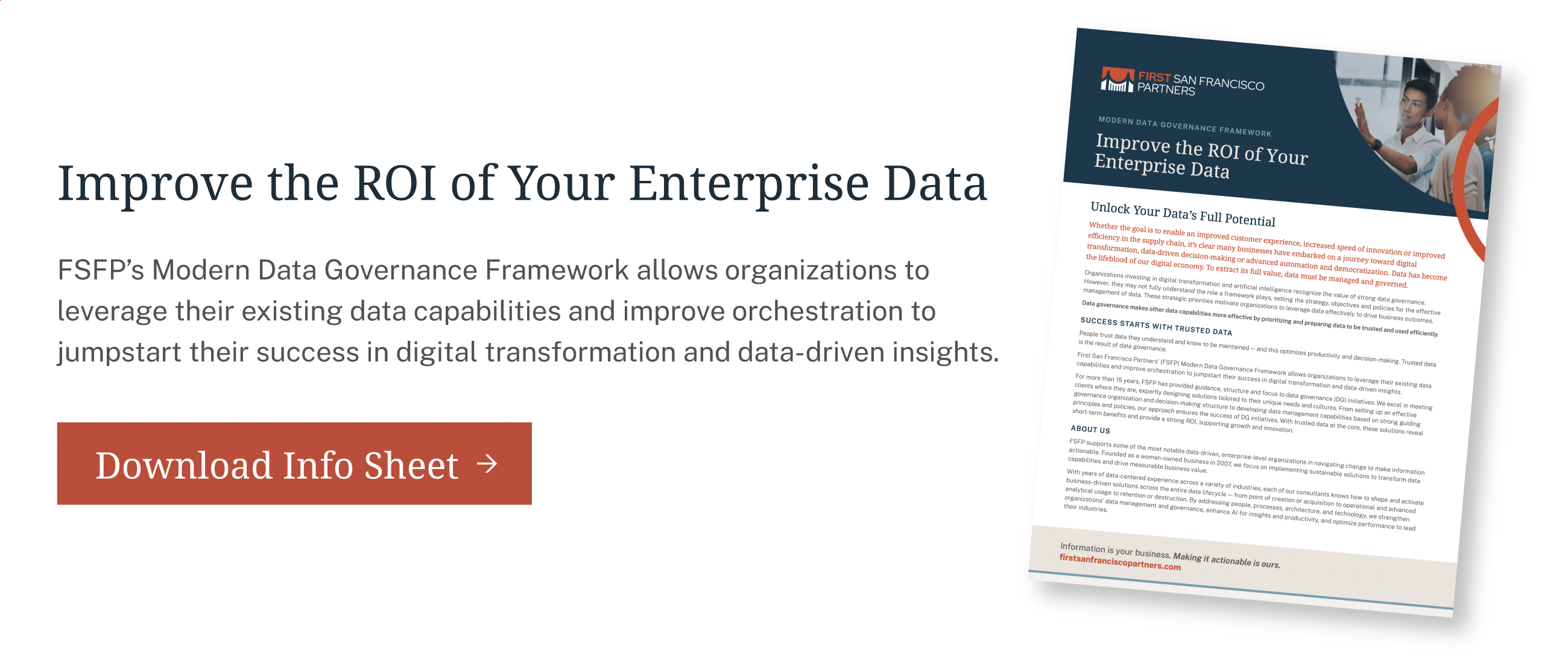People and processes play key roles in the success of data governance programs. Leading organizations also turn to technology to supplement and automate governance processes and help ensure data delivers business value. (According to our State of Data Governance survey, about 80% of companies depend on technology for managing governance.)
What are the governance issues facing your organization? Can they be solved and managed by a simple tool, like Excel or SharePoint? Or is a made-for-data-governance solution better suited for your needs?
Here is how the more sophisticated governance tools, software and platforms can alleviate common business challenges.
1. Standardizes semantics and definitions
This is job number one for data governance: consistency in semantics — that is, how an organization describes its data. Though this can sound simple, complexities abound; it's not just one field and one definition. A key capability for a data governance tool is to enable you to collect concepts and "cross walk" the ways different data definitions are used across the organization.
2. Automates governance capabilities
Policy development is one of the first tasks in a data governance program start-up. Once set in place, these guidelines will be working away for you — somewhat behind the scenes and agnostic of any one data steward or subject matter expert who may come and go.
If your organization gets bogged down in drafting policies, a governance tool can help with this necessary, upfront work. The time you spend developing standards, controls and rules will serve your organization for months and years to come.
3. Delineates roles and responsibilities
Governance program managers must be able to document and track areas that include roles and responsibilities, operating rules, workflows, stewardship guidelines and change management processes.
A data governance tool plays a key role in identifying who does what for governance — and when. It helps you assign and manage roles and responsibilities, as well as capture structures needed to support the program (e.g., working groups and councils) and manage user permission levels.
4. Supports workflow to break down silos
Many business-related tools are purported to break down silos. A data governance tool hits at the heart of this matter with a cross-department contribution to workflow management, which encourages people to collaborate across functional silos. One thing to remember: workflow is often culture- and organization-specific, so make sure the governance software addresses your specific needs.
5. Builds organizational trust in data
When your organization commits to a data governance tool or platform, it immediately moves people forward in getting them to be more comfortable working outside their areas. This common cause for governance is where they often view collaboration and cooperation in a new light. As the weeks turn into months, there should be more collective buy-in on the importance of consistent data usage across business areas — and that's a great thing.
6. Helps manage large volumes of data
A governance tool will also establish meaning and relevance to business metadata, which helps all data users (stewards, scientists, engineers, et al) better manage widely distributed and high-volume data assets. This includes taxonomies to improve navigation, manage reference data and use unstructured data, making it easier to manage complex data sets.
7. Provides structure for regulated industries
Industries like health care and securities are regulated by agencies that require certain data standards, metrics and reporting. For these industries — and a growing number of others — there’s a need to establish formal, auditable oversight of data. Regulatory drivers also demand an organization implements workflow processes and controls.
Give consideration to data governance tools will capture these regulatory agencies' rules and make it easier for your organization to comply with their oversight.
8. Addresses GDPR which impacts many industries
Speaking of regulations, the General Data Protection Regulation (GDPR), which goes into effect May 25 this year, will impact companies who are members of the European Union (EU) and companies throughout the world that collect data from EU citizens. If GDPR is something your organization is concerned about, look for a governance tool that supports and helps you comply with this important regulation.
9. Improves data quality
With good management of semantics, your organization will be able to determine if there are data quality problems or confusion in the definitions and meanings of data. Governance tools shine here as they offer features that help address and manage data issues, data quality remediation and quality metrics.
To be data-driven, govern data smartly
Sooner or later, your spreadsheets and access databases and your tribal knowledge will not be able to keep up with 21st-century data governance needs. Even if you don't start out with a robust governance tool, your program will benefit greatly from some productivity aid.
But be smart and strategic about your choice. A tool that sort of does data governance instead of one designed specifically for the task will likely not keep pace with your needs — and your organization's quest to be truly data-driven will cost more and take longer to achieve.
Article contributed by John Ladley. He is a business technology thought leader and recognized authority in all aspects of Enterprise Information Management. He has 30 years’ experience in planning, project management, improving IT organizations and successful implementation of information systems. John is widely published, co-authoring a well-known data warehouse methodology and a trademarked process for data strategy planning. His books, Making EIM Work for Business – A Guide to Understanding Information as an Asset and Data Governance – How to Design, Deploy and Sustain an Effective Data Governance Program, are recognized as authoritative sources in the EIM field.
Array




